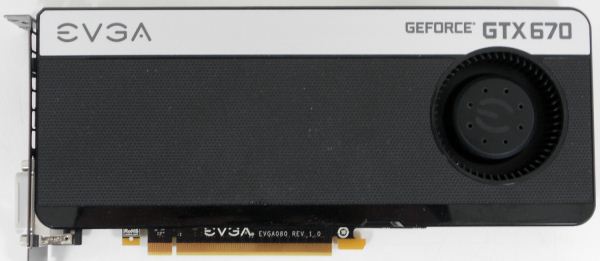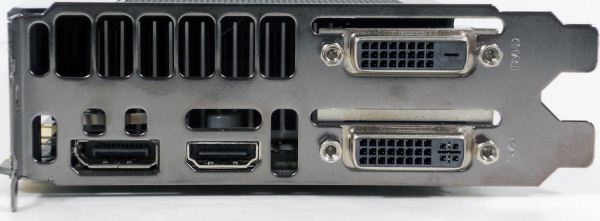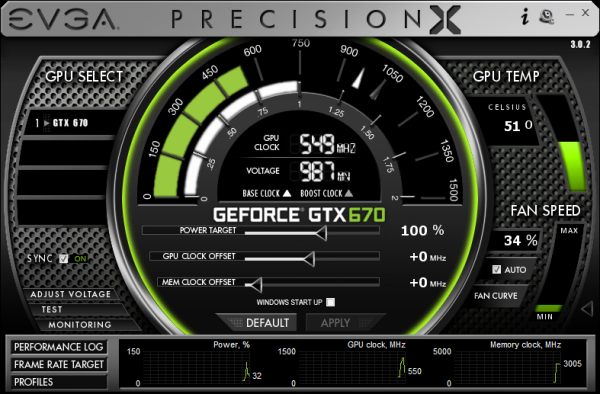NVIDIA GeForce GTX 670 Review Feat. EVGA: Bringing GK104 Down To $400
by Ryan Smith on May 10, 2012 9:00 AM ESTMeet The EVGA GeForce GTX 670 Superclocked
Our second card of the day is EVGA’s GeForce GTX 670 Superclocked, which in EVGA’s hierarchy is their first tier of factory overclocked cards. EVGA is binning GTX 670s and in turn promoting some of them to this tier, which means the GTX 670 Superclocked are equipped with generally better performing chips than the average reference card.
| GeForce GTX 670 Partner Card Specification Comparison | ||||
| EVGA GeForce GTX 670 Superclocked | GeForce GTX 670 (Ref) | |||
| CUDA Cores | 1344 | 1344 | ||
| Texture Units | 112 | 112 | ||
| ROPs | 32 | 32 | ||
| Base Clock | 967MHz | 915MHz | ||
| Boost Clock | 1046MHz | 980MHz | ||
| Memory Clock | 6210MHz | 6008MHz | ||
| Memory Bus Width | 256-bit | 256-bit | ||
| Frame Buffer | 2GB | 2GB | ||
| TDP | 170W | 170W | ||
| Manufacturing Process | TSMC 28nm | TSMC 28nm | ||
| Width | Double Slot | Double Slot | ||
| Length | 9.5" | 9.5" | ||
| Warranty | 3 Years | N/A | ||
| Price Point | $419 | $399 | ||
For the GTX 670 SC, EVGA has given both the core clock and memory clock a moderate boost. The core clock has been increased by 52MHz (6%) to 967MHz base and 66MHz (7%) boost to 1046MHz. Meanwhile the memory clock has been increased by 202MHz (3%) to 6210MHz.
Other than the clockspeed changes, the GTX 670 SC is an almost-reference card utilizing a reference PCB with a slightly modified cooler. EVGA is fabricating their own shroud, but they’ve copied NVIDIA’s reference shroud down to almost the last detail. The only functional difference is that the diameter of the fan intake is about 5mm less, otherwise the only difference is that EVGA has detailed it differently than NVIDIA and used some rounded corners in place of square corners.
The only other change you’ll notice is that EVGA is using their own high flow bracket in place of NVIDIA’s bracket. The high flow bracket cuts away as much metal as possible, maximizing the area of the vents. Though based on our power and temperature readings, this doesn’t seem to have notably impacted the GTX 670 SC.
While we’re on the matter of customized cards and factory overclocks, it’s worth reiterating NVIDIA’s position on factory overclocked cards. Reference and semi-custom cards (that is, cards using the reference PCB) must adhere to NVIDIA’s power target limits. For GTX 670 this is a 141W power target, with a maximum power target of 122% (170W). Fully custom cards with better power delivery circuitry can go higher, but not semi-custom cards. As a result the flexibility in building semi-custom cards comes down to binning. EVGA can bin better chips and use them in cards such as the Superclocked – such as our sample which can go 17 boost bins over the base clock versus 13 bins for our reference GTX 670 – but at the end of the day for stock performance they’re at the mercy of what can be accomplished within 141W/170W.
In any case, as the card is otherwise a reference GTX 670 EVGA is relying on the combination of their factory overclock, their toolset, and their strong reputation for support to carry the card. EVGA has priced the card at $419, $20 over the GTX 670 MSRP, in-line with other factory overclocked cards.
On the subject of pricing and warranties, since this is the first EVGA card we’ve reviewed since April 1st, this is a good time to go over the recent warranty changes EVGA has made.
Starting April 1st, EVGA has implemented what they’re calling their new Global Warranty Policy. Starting July 1st, 2011 (the policy is being backdated), all new EVGA cards ship with at least a 3 year warranty. And for the GTX 600 series specifically, so far EVGA has only offered models with a 3 year warranty in North America, which simplifies their product lineup.
To complement the 3 year warranty and replace the lack of longer term warranties, EVGA is now directly selling 2 and 7 year warranty extensions, for a total of 5 and 10 years respectively. So instead of buying a card with a 3 year warranty or a longer warranty, you’ll simply buy the 3 year card and then buy a warranty extension to go with it. However the extended warranty requires that the card be registered and the warranty purchased within 30 days.
The second change is that the base 3 year warranty no longer requires product registration. EVGA has other ways to entice buyers into registering, but they’ll now honor all applicable cards for 3 years regardless of the registration status. At the same time the base 3 year warranty is now a per-product warranty (e.g. a transferable warranty) rather than per-user warranty, so the base warranty will transfer to 2nd hand buyers. The extended warranties however will not.
The third change is how EVGA is actually going to handle the warranty process. First and foremost, EVGA is now allowing cards to be sent to the nearest EVGA RMA office rather than the office for the region the card was purchased from. For example a buyer moving from Europe to North America can send the card to EVGA’s North American offices rather than sending it overseas.
Finally, EVGA is now doing free cross shipping, alongside their existing Advanced RMA program. EVGA will now cross-ship replacement cards for free to buyers. The buyer meanwhile is responsible for paying to ship the faulty card back and putting up collateral on the new card until EVGA receives the old card.
There’s also one quick change to the step-up program that will impact some customers. With the move to purchasing extended warranties, the step-up program is only available to customers who either purchase an extended warranty or purchase an older generation card that comes with a lifetime warranty. Step-up is not available to cards with only the base 3 year warranty.
Moving on, along with EVGA’s new warranty EVGA is bundling the latest version of their GPU utilities, Precision X and OC Scanner X.
Precision X, as we touched upon quickly in our GTX 680 review, is the latest iteration of EVGA’s Precision overclocking & monitoring utility. It’s still based on RivaTuner and along with adding support for the GTX 600 series features (power targets, framerate caps, etc), it also introduces a new UI. Functionality wise it’s still at the top of the pack along with the similarly RivaTuner powered MSI Afterburner. Personally I’m not a fan of the new UI – circular UIs and sliders aren’t particularly easy to read – but it gets the job done.
OC Scanner X has also received a facelift and functionality upgrade of its own. Along with its basic FurMark-ish stress testing and error checking, it now also offers a basic CPU stress test and GPU benchmark.



















414 Comments
View All Comments
SlyNine - Sunday, May 13, 2012 - link
The 5800 ultra was pretty bad. the 2900XT was pretty bad to. And god forbit if you actually payed for the 5200ultra.The Geforce 2 ultra was a bad value (even tho I bought one of those).
celestialgrave - Thursday, May 10, 2012 - link
"The only other change you’ll notice is that <b>NVIDIA</b> is using their own high flow bracket in place of NVIDIA’s bracket. The high flow bracket cuts away as much metal as possible, maximizing the area of the vents. Though based on our power and temperature readings, this doesn’t seem to have notably impacted the GTX 670 SC."First Nvidia meant to be EVGA?
Ryan Smith - Thursday, May 10, 2012 - link
One would assume so. Thanks.Lepton87 - Thursday, May 10, 2012 - link
Ever since 6870 launch you had strict policy of no OC cards in launch articles yet you did it again. Where's the consistency?Ryan Smith - Thursday, May 10, 2012 - link
To be clear, our policy is no COMPETING OC cards in a launch article. You guys have specifically indicated that you want us to avoid the FTW scenario. If someone launches a competing card at the same time as another major launch, that card will be in a separate article and judged as such.However we've bundled retail cards into reviews for quite some time; this isn't any kind of change. It allows us to quickly cover semi-custom cards that are similar to the original while not being redundant.
raghu78 - Thursday, May 10, 2012 - link
The HD 6870 review was HD 6870 stock with GTX 460 OC. Now you have 670 and 670 OC cards in this review. I don't see any problems in a HD 7950 OC being pitted against a 670 OC.silverblue - Thursday, May 10, 2012 - link
Yes, but we're talking the 670 vs. overclocked 670s. The 6870 review threw an overclocked 460 into the mix which takes a lot of attention away from the actual card being reviewed.Any overclocked AMD vs. NVIDIA comparisons should be made in a separate article.
RussianSensation - Thursday, May 10, 2012 - link
It's extra data being presented. If you don't want to read it, just ignore it. It doesn't hurt the review in any way. If anything it shows that an overclocked 7950 has NO CHANCE to match an overclocked 670. The direct competitor to the 7950 is therefore superior based on this review. It's not necessary to see HD7950 oced vs. 670 per say given the massive performance lead in games such as BF3, Batman AA, etc. HD7950 no longer makes any sense for $399.Morg. - Thursday, May 10, 2012 - link
TWIMTBP v2.0 : now hidden for more nerdrage and forumwarsRussianSensation - Thursday, May 10, 2012 - link
Well some people here are always too quick to blame fanboys on logical arguments and facts:"With performance that comes awfully close to a fully enabled GK104, the GTX 670 poses a nightmare scenario for AMD. Fresh off a round of price drops, they now have to contend with a card that retails for the same price as a HD 7950 but runs dead even with a HD 7970 in everything except multi monitor resolutions. To add insult to injury, the Radeon cards fight a losing battle in the performance per watt and acoustics categories as well. Free game offer or not, without another $50 to $75 shaved off, we can’t think of a single scenario where a gamer should choose a Tahiti-based card over the GTX 670. "
http://www.hardwarecanucks.com/forum/hardware-canu...